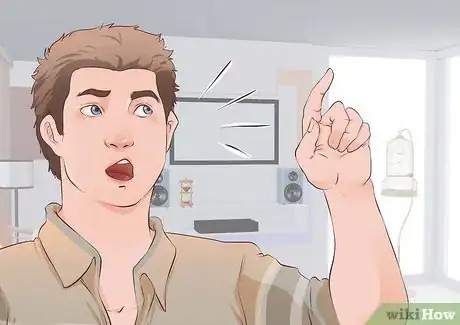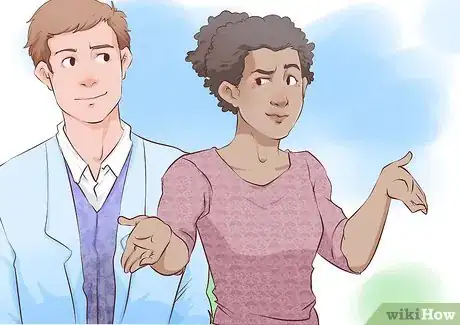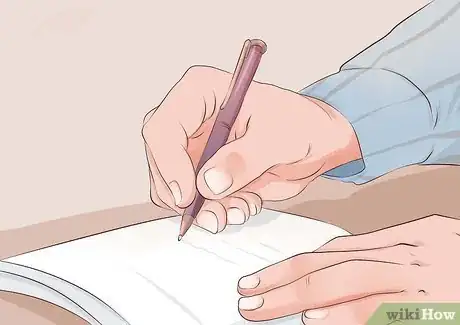This article was co-authored by Maureen Taylor. Maureen Taylor is the CEO and Founder of SNP Communications, a leadership communications company based in the San Francisco Bay Area. She has been helping leaders, founders, and innovators in all sectors hone their messaging and delivery for almost 30 years, and has worked with leaders and teams at Google, Facebook, Airbnb, SAP, Salesforce, and Spotify.
There are 8 references cited in this article, which can be found at the bottom of the page.
This article has been viewed 68,185 times.
Although it may seem counterintuitive, most of our communication with other people has less to do with words, and more to do with our body language and tone.[1] Many people struggle to express their feelings and emotions clearly. But if you want to know how to be more expressive, you’re in the right place. We’ll walk you through everything you need to know about getting more in touch with the way you feel, and communicating those emotions to others.
Steps
Communicating with More Non-Verbal Expression
-
1Use hand gestures. There is evidence that using hand gestures when you talk makes people more likely to listen to you.[2] It can also help you remember what it is you are trying to say.[3]
- Don’t make them too big! Your hand gestures should be kept "inside the box". This means keeping your hands inside the area of the top of your chest and the bottom of your waist. Outside of that, and they will become distracting.[4]
- Make your hand gestures smooth. When you use your hands to add expression, it should appear as natural as possible. You want to avoid looking like a robot.[5]
- The best way to make sure they look fluid and natural is to practice in front of the mirror.
- If you give a speech, you could also film yourself to see what gestures you tend to use often.
-
2Use your face to convey emotion. This takes a lot of practice, most of which you must do on your own. The best communicators, however, know how to use their face in order to make their point.[6]
- Arching an eyebrow can convey that you are surprised or skeptical about something.[7]
- Frown when you disapprove or are concerned about something.[8]
- Grimace when you are worried, afraid, or in pain.[9]
- Most importantly, smile! If you are happy about something, pleased with an outcome, or simply happy to be in someone's company, you should smile to express this emotion.[10] Nearly everyone enjoys a nice smile.
Advertisement -
3Become aware of your body language. This can be tricky for some. However, your body language is usually the first thing people will notice, so it is important to be aware of what you are conveying.[11]
- If you want to appear more confident, assume a “power pose”.[12] This means standing with your feet apart and your chin slightly elevated (not pointed in the air). If you are sitting in a chair, you might lean back and put your hands behind your head. This will not only make you look more confident, but it may also help you feel more confident.[13]
- If you want to demonstrate agreement, mirror the expressions and postures of the person you are talking with.[14] This doesn’t mean mimicking them completely, but rather noticing the general expressions and body language, and letting yourself slip into a similar posture.
- To have an open friendly posture, make sure your arms are not crossed, but relaxed at your sides with your palms open (i.e. not balled into fists). If you are sitting, uncross your legs, and keep them relaxed. Point your body in the direction of the person you are talking to.[15]
Using Your Voice More Expressively
-
1Vary the volume. This can help keep your voice from becoming monotone. You should always speak loudly enough so that everyone who is listening can hear you, but you can vary the volume to make it more interesting. Be careful that you aren't shouting, though!
- When you are telling a story you can begin quietly and raise the volume as you reach the climax of the story.
-
2Vary the pitch. This is very important for being more expressive. If you raise your pitch, your voice will become slightly higher, if you lower your pitch, it will become slightly deeper. For example, when asking a question, most people tend to raise the pitch.
- If you want to make a positive statement, or agree with an idea, ending a statement on a slightly lower pitch is a good idea. If you want to create doubt in your listener, end in a slightly higher pitch.
- If you want to sound authoritative, you should maintain a slightly lower pitch.[16]
-
3Use pauses. When speaking, this can be difficult. Often a pause of even a few seconds can seem like an eternity if you are a bit shy in social situations. However, using pauses creates drama and makes you appear more confident.[17] Pausing can also give listeners a chance to absorb what you have said.
- Don’t pause for too long! A few seconds should be sufficient.
-
4Practice speaking. If you find that you have a hard time being expressive with your voice, then keep practicing!
- You can do this by practicing speeches by yourself, in front of a mirror.
- You could also do this in a public speaking class, or with a trusted friend or teacher. However you do it, the only way to get better is to keep trying!
Expressing Yourself Through Other Mediums
-
1Learn to play an instrument. If you are looking for hobbies that will allow you to become more expressive, consider learning an instrument. Music is often seen as a great way for expressing one’s self.[18]
- Choose an instrument that you feel will allow you to express yourself accurately. This simply means that you should choose an instrument that excites you. Many choose the guitar, but if the clarinet or oboe feels right for you, then try that.
-
2Write in a journal. Keeping a journal is believed the be a very good way to express yourself.[19] It can help you work out problems and work through thoughts and ideas in a way that is unique to you.
- You can keep your journal private, or you can share it with others if you wish.
- You can also keep your journal on paper or in a document on your computer.
- Try writing down the things that happened on any given day, and writing down how these events made you feel.
- In your journal you can write letters to people you don’t get to see anymore, or write letters to say things you are afraid to say. Maybe you will send them, maybe you won’t.
- Write down dreams and ideas. Think of things you’d like to accomplish in your life and write those down.
-
3Draw, color, or paint. Whichever medium you choose, do it as freely as you like. You can simply pick up a color and see where your hand takes you. Doing this on a regular basis will not only improve your skill, it will give you an outlet where you can express feelings and emotions in a way that has meaning only for you.
-
4Sing. If you enjoy singing, then do so. You can write your own song or you can just sing songs that you enjoy. If this helps you to express things you cannot or don’t want to put into words in any other way, then embrace it!
- If you want to, you can do this at karaoke, or open mic nights, or you can just do it in the privacy of your own home or bedroom. The important part is not who hears it, but that you have found a way that helps you express yourself.
-
5Write poetry. Writing poetry has been an ideal method of self-expression for hundreds of years. Many people use it to express complicated emotions in an eloquent way, and with practice, you can improve your skills immensely. However, if you are simply looking for a method for expressing yourself through poetry, it doesn’t have to be perfect.
Expert Q&A
-
QuestionHow can I express anger without hurting someone's feelings?
 Maureen TaylorMaureen Taylor is the CEO and Founder of SNP Communications, a leadership communications company based in the San Francisco Bay Area. She has been helping leaders, founders, and innovators in all sectors hone their messaging and delivery for almost 30 years, and has worked with leaders and teams at Google, Facebook, Airbnb, SAP, Salesforce, and Spotify.
Maureen TaylorMaureen Taylor is the CEO and Founder of SNP Communications, a leadership communications company based in the San Francisco Bay Area. She has been helping leaders, founders, and innovators in all sectors hone their messaging and delivery for almost 30 years, and has worked with leaders and teams at Google, Facebook, Airbnb, SAP, Salesforce, and Spotify.
Communications Coach You don't want to reply with a knee-jerk reaction. Instead, don't do anything in the moment, and give yourself time to think before you get back to that person.
You don't want to reply with a knee-jerk reaction. Instead, don't do anything in the moment, and give yourself time to think before you get back to that person.
Warnings
- It is likely that while you are practicing and putting yourself into new situations, you will stumble and say the wrong thing or make the wrong hand gesture. You might even accidentally offend someone. Take these as learning experiences, rather than as failures.⧼thumbs_response⧽
References
- ↑ http://www.doctornerdlove.com/2013/04/power-expressiveness/
- ↑ http://www.scienceofpeople.com/2015/08/how-to-speak-with-your-hands/
- ↑ http://www.scienceofpeople.com/2015/08/how-to-speak-with-your-hands/
- ↑ http://www.scienceofpeople.com/2015/08/how-to-speak-with-your-hands/
- ↑ http://www.scienceofpeople.com/2015/08/how-to-speak-with-your-hands/
- ↑ http://www.artofcommunicating.com.au/public_speaking%20tips/body_language_expression.html
- ↑ http://www.artofcommunicating.com.au/public_speaking%20tips/body_language_expression.html
- ↑ http://www.artofcommunicating.com.au/public_speaking%20tips/body_language_expression.html
- ↑ http://www.artofcommunicating.com.au/public_speaking%20tips/body_language_expression.html
- ↑ http://www.artofcommunicating.com.au/public_speaking%20tips/body_language_expression.html
- ↑ http://www.amanet.org/training/articles/10-Powerful-Body-Language-Tips.aspx
- ↑ http://www.amanet.org/training/articles/10-Powerful-Body-Language-Tips.aspx
- ↑ http://www.amanet.org/training/articles/10-Powerful-Body-Language-Tips.aspx
- ↑ http://www.amanet.org/training/articles/10-Powerful-Body-Language-Tips.aspx
- ↑ http://changingminds.org/techniques/body/open_body.htm
- ↑ http://www.amanet.org/training/articles/10-Powerful-Body-Language-Tips.aspx
- ↑ http://sixminutes.dlugan.com/pause-speech/
- ↑ https://www.psychologytoday.com/us/blog/naked-truth/201410/music-is-what-feelings-sound
- ↑ https://montrealtherapy.com/33-ways-to-use-your-journal-for-self-discovery-and-self-expression/
About This Article
To be expressive, use hand gestures to emphasize what you’re saying when you're speaking to others. You could also try varying the volume and pitch of your voice so that it doesn't sound monotone. Additionally, try to include pauses when you speak to create drama and make you appear more confident. If you want to express yourself to others non-verbally, stand with your feet apart and your chin slightly elevated to indicate confidence with your body language. For tips on how to express emotion using your face, keep reading!







































































